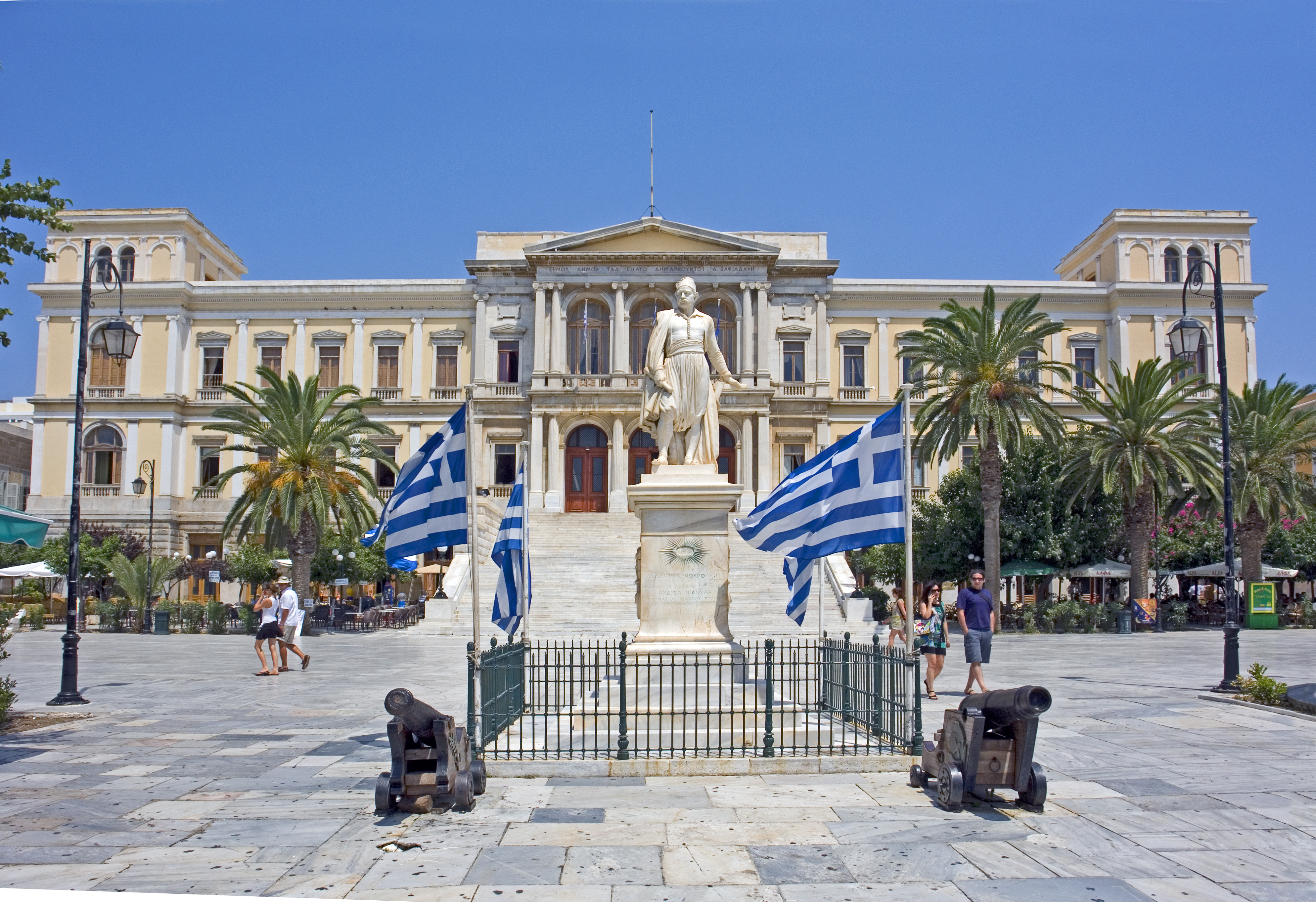This is one of the largest Town Halls in the country. It is the work of German architect Ernst Ziller, founded in 1876 and inaugurated in 1898. It is built in the axis of the road E. Venizelos and it appears as a three storey bulding to the square and, because of the height difference, two storey to the rear road. There are two long wards with five vertical window axes each and towers at the four corners of the building.
The ground floor is built with marble. The first floor, with a monumental staircase (15.5 m. wide) is of Tuscan style. The second floor is of Ionic style and the towers are of Korinthian style. The central part is entirely made of marble and you will see an inscription explaining that the Municipality of Ermou erected this building in the honor of mayor D. Vafiadakis.
From the main entrance we enter the lobby with the Tuscan columns and the monumental hanging ladder (1.95 m. wide) leading to the first floor. On the left of the staircase, there is the bust of D. Vafiadakis. The staircase is covered with a glass roof. You can see the Town Hall rooms arranged in rows.
The hall of the municipal council meetings is of particular interest. In the lobby there are the portraits of all Mayors. In the room, you will see oil paintings of King George I (1864-1912) and Queen Olga, by artist Prosalentis. In 1998 the building was renovated, the glass roof was reconstructed and artist Anna Vassilaki used original designs by Ziller to paint the walls of the building. You will find older ceiling paintings on the left of the ground floor.
In addition to the municipal services, the town hall also houses the Courthouse, the Land Registry, the Archaeological Museum and other public services.
The Town Hall is built in a plot of land of 2,800 sq.m. which was bought in 1858. Many engineers (A. Georgantas, A. Zinopoulos, Vaugarni) took up the design of the building, but the process was being delayed. In 1871 the municipality finally gave the project to the famous German architect E. Ziller. Of all the proposals Ziller made, his first drawings are kept in the Cyclades Prefecture files and it is clear that the construction of a large complex with the possibility to accommodate other public services was planned from the beginning but it exceeded the financial capabilities of the municipality. It seems that the magnificent building was important in order to boost the morale of the population at a time when commercial decline was very noticeable. D. Vafiadiakis strongly supported the construction of the building. The execution of the project was facilitated by the officials of the municipality, John Vlysidis and Dimitrios Eleftheriadis.
The foundation of the Town Hall took place in January 1876 in the presence of Ziller and city authorities. Very soon, the local press voiced objections concerning the construction costs and the city council proposed to re-evaluate or even stop the construction of the building. However, D. Vafiadakis won the municipal elections of 1879 and the work was continued. Vlysidis and Eleftheriadis suggested more cost effective solutions and with Ziller’s agreement appropriate modifications were made. Nevertheless, the municipality had to borrow money: the City Hall cost 1.300.000 drachmas.
Various tasks were assigned to different contractors, including Nick. D. Ieronymos (foundation), Peter N.Vamvakas and Minas Economou (masonry), Leondis Georgiou and Georgios Psaros (marbles), X 'G. Grekas, and machinist St. Mparmpetas (placing of the iron roof). The use of metallic pillars instead of wooden ones initially was a decision of D. Vafiadakis who ordered them directly from a German firm without going thorough auction (1883).
The building was completed in 1889 and the Town Hall was moved there in 1891 while the interior construction was still work under progress under the supervision of John Koomeli, engineer and professor at the Technical University from 1878 to1882. D. Vafiadakis lost the municipal elections of 1887 by the rising power, Constantine Tsiropina. However, he won the elections of 1895 and could finally be mayor at the end of his life in the massive building that he had dreamt about.
Open hours
- The Town Hall is open for visits every day (Monday to Friday) from 9:00 to 15:00.
- July and August tours are possible from 11:00 to 13:30 from “Mikrous Xenagous” (=Young Guides).



